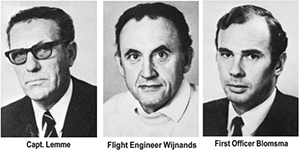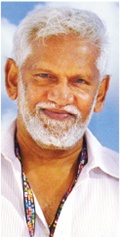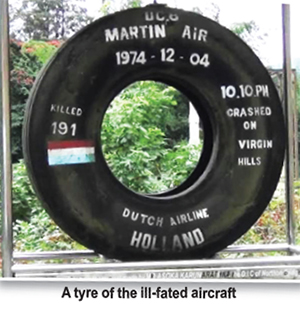
Source:Island
A DC-8 aircraft, belonging to Martinair, crashed into the Anjimalai mountain range, also known as the Seven Virgins, on 04 December 1974. The accident happened around 1015 PM and the location was in the vicinity of Maskeliya. This has been the worst ever air disaster in Sri Lanka; 191 lives were lost with no survivors.
Corona curfews give us time to read, and in my isolation, at home, I have been pulling out ‘bucket-listed’ stories to munch. Most articles I browsed through about the Martinair DC-8 crash had covered all aspects of this horrible disaster. Adequate details were available to re-construct the story and come to reasonable conclusions on what may have happened.

We know the easy way out as regards most aeroplane crashes has been the first-choice of the hit-parade – PILOT ERROR. The captain is buried beneath the Seven Virgins hills in a shamed silence. So is his First Officer and the Flight Engineer. The case is closed and forgotten. I have no defence to rub on behalf of the crew to give even a shallow coating of an excuse. There, however, is a ‘BUT’ I need to mention here. On one side, we have technology inundated with fancy aviation jargon. Add to that a half-burnt Black Box and communication tapes between the pilot and the controller, plus all the details of the flying records of the crew and what they have done and what they have not done. Then comes a hundred titbits of aeronautical specifics that act as tinsel to an investigation.
All that is fine and valid to be used at roundtable conferences where aviation-related head umpires and leg umpires, third umpires plus match referees discuss and make decisions, taking all the time in the world. It is not the same for the Captain and his crew. No doubt they are professionally competent, but some decisions to be made in an aeroplane are instant. You win some and you lose some and the ones you lose may have devastating repercussions. You may not even be living to tell your side of the story. A few seconds make the difference between life and death. In such calamitous situations we tend to forget that the most lethal ingredient in an aviation disaster is the Human Factor.
The Captain is not an infallible demigod who jumped out of Mount Olympus and sits in the cockpit of his aeroplane. He is human and so are his crew. They are not different from the ordinary people like you and me. I have been a Captain for a considerable number of years. I have made many mistakes flying aeroplanes. I humbly say I was lucky that I escaped without an accident. There is nothing courageous or brilliant about that; it is simply the way fate rolled the dice. Such would be the story of any Captain. Admitted or not, it is the truth, the absolute truth.

Scales of justice
The scales of justice in an aviation accident investigation is held by competent authorities. In the case of the Martinair DC-8 crash, there were three Civil Aviation Departments associated with the inquiry. Sri Lanka, the Netherlands, and Indonesia, plus there would have been the McDonnell Douglas Company that built the aeroplane and insurance companies that were present to protect their dollar. There were whispers about the Doppler system in this aeroplane having errors that caused inaccuracies in the ‘distance to go’. It was also said that the crew had not been informed of this. There is nothing to substantiate such statements and as such, it is best that I leave them out and let them lie buried along with the aeroplane. I also read that the co-pilot had a traumatic childhood and that could have affected his behaviour when approaching to land. I make no comment on such absurdities.
Let me now take you to the story of the DC 8 that crashed into the Seven Virgins mountain range. The accident tragically killed 191 innocent people (182 passengers + 9 crew). It sure is a terrible night to remember.
The flight was from Surabaya, Java, to Jeddah via Colombo, which was a re-fuelling stop. This was Muslim pilgrimage time to Mecca for the Haj. Devotees came from all parts of the world. Some flew in on private jets but most travelled on chartered aeroplanes. The flight that took off from Surabaya was a DC-8 55CF aeroplane, owned by Martinair of the Netherlands; it had been leased by Garuda Indonesia to fly the Haj charters. In command was Capt Hendrik Lamme, a 58-year-old very experienced pilot who had flown 27,000 plus flying hours, of which 4,000 were on DC-8s. The First Officer Robert Blomsma had 2,480 hours and was new on the DC-8 type with 47 hours. The third crew member, the flight engineer was Johannes Wijnands, who had flown 3,000 hours on DC-8 type aeroplanes. Back in the cabin there were six crew members, four were Dutch and others Indonesian. The aircraft had a Dutch registration of PH-MBH and was less than 10 years old. The flight plan filed call-sign for the flight was MP 138.
Here, I must explain to the reader something about the navigational instruments that the aeroplane had. I want to make it as simple as possible for a non-aviator to understand.
The route from Surabaya to Sri Lanka is mostly oceanic. It starts with an airway called Red-61 and extends on a North-Westerly direction till it reaches the Sri Lankan Flight Information Region (FIR – 92 East longitude) and follows route Golf-462 to cross the coast at a waypointlocated over Yala.
This reporting point, unfortunately, had no Radio Aid for the pilots to  cross
cross
check their navigation when flying overhead. The primary navigation system that was in use by Martinair was called Doppler. This was operated worldwide by many airlines, and during that era it was a primary navigational aid for jet aeroplanes flying long haul sectors. Doppler gave the pilots a digital reading of the distance to go to the waypoint it was heading to. However, Doppler system was not overly accurate when flying over water for a long period and had to be updated over a radio beacon or a known geographical position (maybe a river or town) to maintain its accuracy. Flight MP 138’s route initially had radio beacons to update the Doppler. But the final ocean crossing before the coast of Sri Lanka had no radio beacon for the crew to update the Doppler position. That was a long leg, too long to fly without an update.
The last point the DC-8 could have done a navigational cross-check would have been at a waypoint closer to Banda Archi airport, which was about 135 miles right of their track. From there Capt. Lamme still had to fly close to two hours to reach the coast of Sri Lanka. He was navigating now purely by rudimentary ‘dead-reckoning’ and Doppler ‘distance to go’ readouts without any cross-check to update his position.
Flight MP138 crossed the FIR at 8.27 pm local time – six minutes earlier than the estimate. Calculating its speed by distance between two waypoints and time taken, the ground speed would be 478 at eight miles a minute. Six minutes would be almost 50 miles. The FIR was about 850 miles from the Sri Lankan coastal waypoint. Maybe, Capt. Lamme and his crew were getting a wrong ‘distance to go’ reading from their Doppler. It is difficult to fathom whether it was because of the reported fault in this particular aeroplane Doppler or it was because of a very long sea track flown without an update. It could even have been both.
Already there had been a six-minute (50 miles) correction made. Was it correct or was it a Doppler error? There was no way to cross check and update. If it had been a Doppler fault, that could have caused the Martinair DC-8 to fly all the way to its death in Maskeliya.

Flight MP 138 first contacted the Colombo Air Traffic Control located at Ratmalana at 9.52 PM and reported 130 miles out at 35,000ft. They were only going by the Doppler. The controller answered ‘MP-138 clear descend 10,000 when ready and call 50 miles from Katunayake.” When Capt. Lamme commenced his descent by what his Doppler reading displayed, his actual position would have been 50 miles east of where he thought he was. Unfortunately, Katunayake Airport at that time did not have Approach Radar nor a Distance Measuring Equipment (DME), which would have digitally told the pilot exactly how far he was from the airfield.
Few minutes later the DC-8 called “50 miles” and was cleared to 6,000 and handed over to Colombo Approach Control at Katunayake. The First Officer who was doing the radio called Colombo Approach at 10.08 PM and reported he was ‘one four” (14) miles from the Katunayake airport passing 7,000 for 6,000. Approach Control had no Radar to see him. The controller had to go purely by the MP 138’s estimate of 14 miles from the airfield. He cleared MP 138 to 2000 ft and told him to call “field in sight” or overhead the KAT radio beacon.
“Roger, cleared 2000, to KAT or field in sight.” This was at 1010 by the first Officer.
That sadly was the last communication!
On descent, the DC-8 hit the 5th of the Seven Virgins mountains at a height of 4,354 feet. The impact place was about 65 miles from Katunayake. When F/O Blomsma reported 14 miles from the airport, he was most certainly giving the distance from the cockpit Doppler. He had to read from a possible error-tainted Doppler. If you add 14 miles to the error of 50 miles on the Doppler the answer is 64. Give or take a few miles for the random calculation I am doing, and then perhaps the 64 coincides with the distance from Katunayake to the place where the crash occurred in the Anjimalai hills.
The only other explanation for Capt. Lamme to initiate an early descent could have been a wrongly interpreted weather radar sighting of the eastern coast. These were black and white radar displays and it is possible that a low cloud could have been mistaken for the coast maybe 50 miles before ALGET.
I, in no way, can say what I have written is the gospel truth. I have no crystal-clear facts to ponder on. It is just my opinion I am stating. I do have some knowledge on Doppler matters as I have flown these routes in similar aeroplanes using Doppler navigation. Many opinions are expressed by journalists about this disaster. How true such inferences are is debatable.
I was greatly assisted by Sri Lankan Air Traffic Controllers and communication officers; some of them handled MP 138 arrival. I am deeply grateful to them for their first-hand information.
The possibility remains that Capt. Lamme may have commenced his descent approximately 50 miles before the planned point to leave 35,000.
The aeroplane crashed. There were many factors that left room for or would have contributed to human error.
Capt. Hendrik Lamme was guilty of being a human being!
Today, people driving past the Norton Bridge town see a strange sight. A structure displaying a large tyre. It is a wheel from the DC-8 that crashed into the Seven Virgins mountains. It could be all that was left of that magnificent aeroplane owned and flown by the Dutch. If one is interested, there is a place where one should stop on the road from Norton Bridge to Maskeliya. A plaque of remembrance is there, erected in memory of those who are buried around this place at the foot of this hill. The Martinair crew and the Indonesian pilgrims who died on the slopes of the mountain were buried in a common grave by the roadside. People say flowers do get placed, off and on, at the memorial. In remembrance of whom we know, but by whom is the question.
Up in the mountain is the main memorial, a stone pillar-like monument erected at the actual crash site. Wind-swept and rain-soaked it stands in its forgotten loneliness. Perhaps, it whispers its sadness amidst the Seven Virgins mountain range. The column has been erected in remembrance of the 191 innocent people who died there on a sorrowful December night, a long time ago.






